U.s. A Baby Dies Amid Squalor. And a Family's Secret Is Revealed
At start glance, she thought it was a Halloween prank.
The puffy corpse slumped over the chair had no eyes, nose or oral cavity — just hair on a skull, and bones sticking out from nether a red sweater and plaid pants.
"How sick," Linda Kajma said to herself before venturing through the rest of the business firm in search of her missing cousin.
It was Thanksgiving weekend and 80-yr-sometime Sally Honeycheck, who for decades lived in a run-downward Detroit neighborhood on Joseph Campau nearly the Polish Yacht Club, wasn't answering her phone. Then Kajma went looking for her, only to detect that her eccentric cousin had been secretly leading a hellish existence, surrounded by filth, rats, feces and mountains of ataxia. In the end, information technology swallowed her whole.
The horrifying effigy that Kajma saw in the chair was her cousin.
Honeycheck, an avid Avon makeup collector who had her hair done weekly and dressed impeccably for church functions, had died alone in the filth of her kitchen, sitting in a nylon blue lawn chair under a picture show of the Last Supper. She was surrounded by garbage a foot deep — empty sardine cans, stacks of greeting cards, accept-out numberless, burned-out appliances and dirt-stained walls.
She had been eaten by her dog and rats.
In the next room was Honeycheck's deceased Rottweiler, Jack, another victim of the house that had no heat, rat-chewed mattresses, squid-like fungi growing out of the walls and dirt-crusted floorboards that sagged so much that Kajma fell through the kitchen floor.
Read more: vii signs that clutter in your home is more beingness messy
For nearly vii decades, this is where the Honeycheck sisters lived quietly together, planting flowers and lilac bushes, collecting baseball memorabilia and ordering clothes, makeup and jewelry by the box-loads. The century-onetime house with six stained glass windows in Detroit'south Poletown neighborhood was their sanctuary. Their parents bought the 2-story, ane,700-foursquare human foot domicile in 1951, raised their children in that location and never left — not during the 1967 riot or after, when the neighborhood emptied out and well-nigh white folks moved to the suburbs.
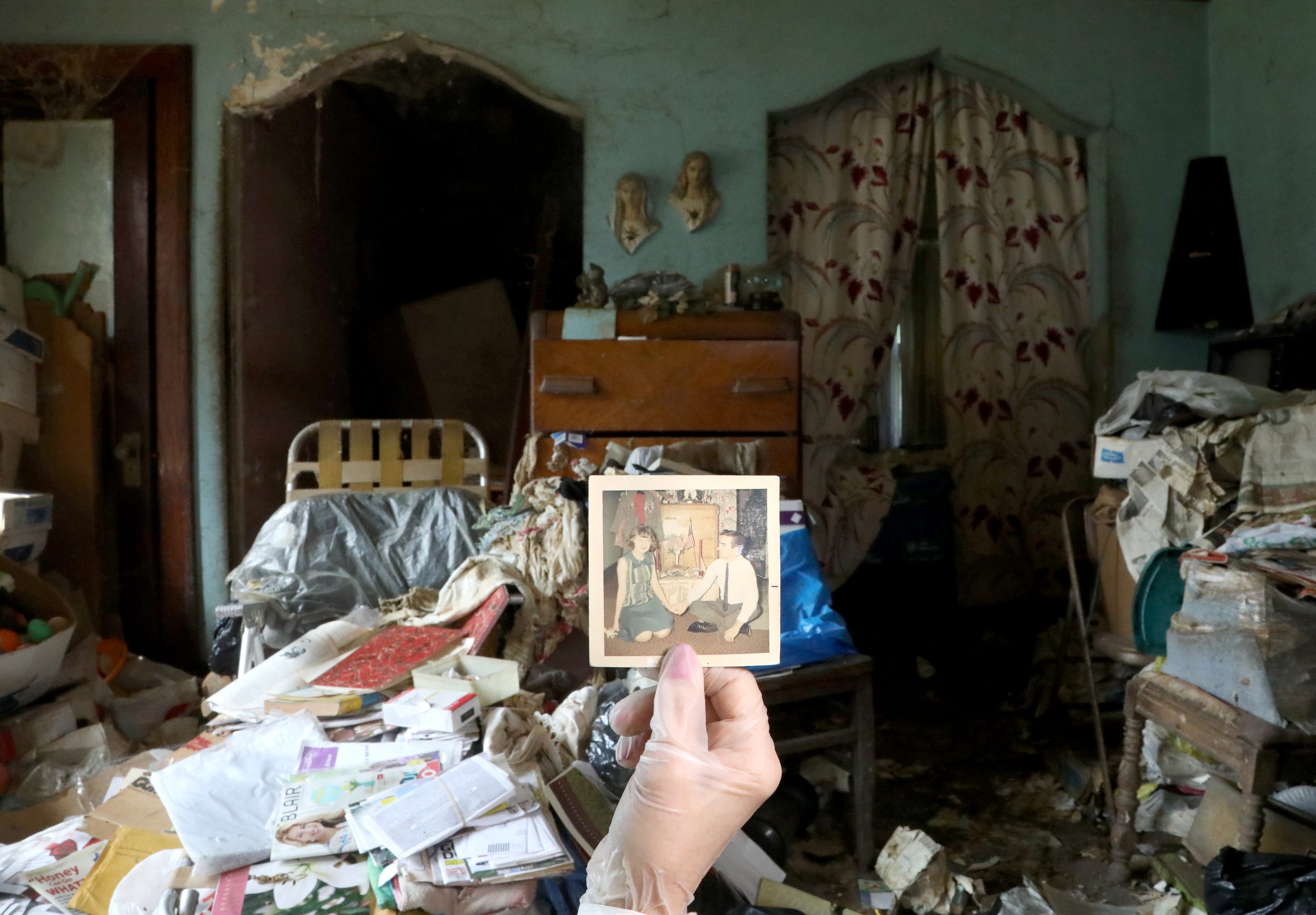
The Honeychecks stayed. And somewhere forth the way, in their golden years, something happened to the sisters, something that slipped by relatives and friends.
In that house, they closed the blinds and shut the doors.
They ordered takeout and had groceries delivered.
No one stepped foot through the door: Not family unit. Not the boy who used to deliver their food. Not friends who gave them rides.
The Honeycheck sisters slowly slipped into an completeness of hoarding and squalor.
Nobody noticed, until information technology was too belatedly.
"No i should have to live like this. No one should die like this," Kajma said while poring through the clutter i Sunday afternoon in a hazmat suit, banging on the walls with a crowbar to scare the rats away. "We suspected that they were hoarders. But I never imagined the degree of hoarding. Information technology's unfathomable."
From the curb, however, all seemed fine. The house and porch were painted. The lawn was mowed. The bushes were trimmed. And when they left the business firm, the Honeycheck sisters were always put together.
In a photo snapped at a church building fundraiser one month before she died, Honeycheck is seen in a well-coiffed hairdo, lipstick, earrings and a long gold necklace draping her navy top. She'due south clutching a $10 bill to purchase a l-50 raffle ticket to back up St. Josephat Catholic Church building, a historic landmark in Detroit.
"I know it's an affliction," said Kajma, 68, of Troy. "But if you met them on the street you'd never, ever know. If you looked at the outside of the house ... y'all'd never know that this nightmare was in here."
'Break in. Something's wrong'
Honeycheck died sometime between Nov. 12 — the twenty-four hours she checked herself out of a hospital — and Dec. 1, the day her trunk was discovered.
For 19 days, no i reported seeing her or hearing from her. It wasn't until Thanksgiving Twenty-four hour period that Kajma noticed something might exist wrong.
The last fourth dimension Kajma had spoken to Honeycheck was the get-go calendar week of Nov 2018. She had called Honeycheck to thank her 2nd cousin for mailing her two holy cards and two relics of Father Solanus Casey, and to tell her how her mother was doing. Kajma's mother was ill at the fourth dimension, and Honeycheck had mailed the "Blessed Solanus" holy cards to her for encouragement.
This was typical of Honeycheck, a devout Catholic and parishioner at Saint Hyacinth. Her home was adorned with pictures and sculptures of the Virgin Mary and Jesus Christ — their dusty faces hanging on faded turquoise walls amongst sheets of cobwebs and antique piece of furniture cached beneath boxes.
Kajma talked to Honeycheck almost one time a month, saw her at church building festivals and funerals and called her on holidays.
The past Thanksgiving, however, Honeycheck didn't answer her phone when Kajma rang. Kajma phoned her through the holiday weekend, just still no reply. Worried, Kajma called Detroit police on Monday, Nov. 26, and asked for a well-check.
"I knew something was wrong. The cops went out and called me and said, 'At that place's no answer,' " Kajma said, noting police force "knew they had a dog and the dog wasn't barking."
Kajma told police to pause in the house, just the officers said a break-in wasn't warranted. They advised her to check the hospitals, she said, adding constabulary had learned the sisters were recently hospitalized.
Later that night, Kajma found Sally Honeycheck'southward sister, Lorraine, at Detroit Receiving Infirmary. She was on a ventilator and had been at that place since suffering a stroke on Nov. 10. But Sally wasn't at the hospital — and then Kajma chosen police force back and asked them to run into her at the Honeycheck's house.
At 9 p.thousand. that night, constabulary met Kajma outside the business firm on Joseph Campau. They knocked on the door, but nevertheless no answer. She pleaded with the officers to break down the door, just to no avail.
"They said, 'We're non breaking in.' I said, 'I'm telling you, she'south in at that place,' " said Kajma, adding police convinced her to file a missing person's report.
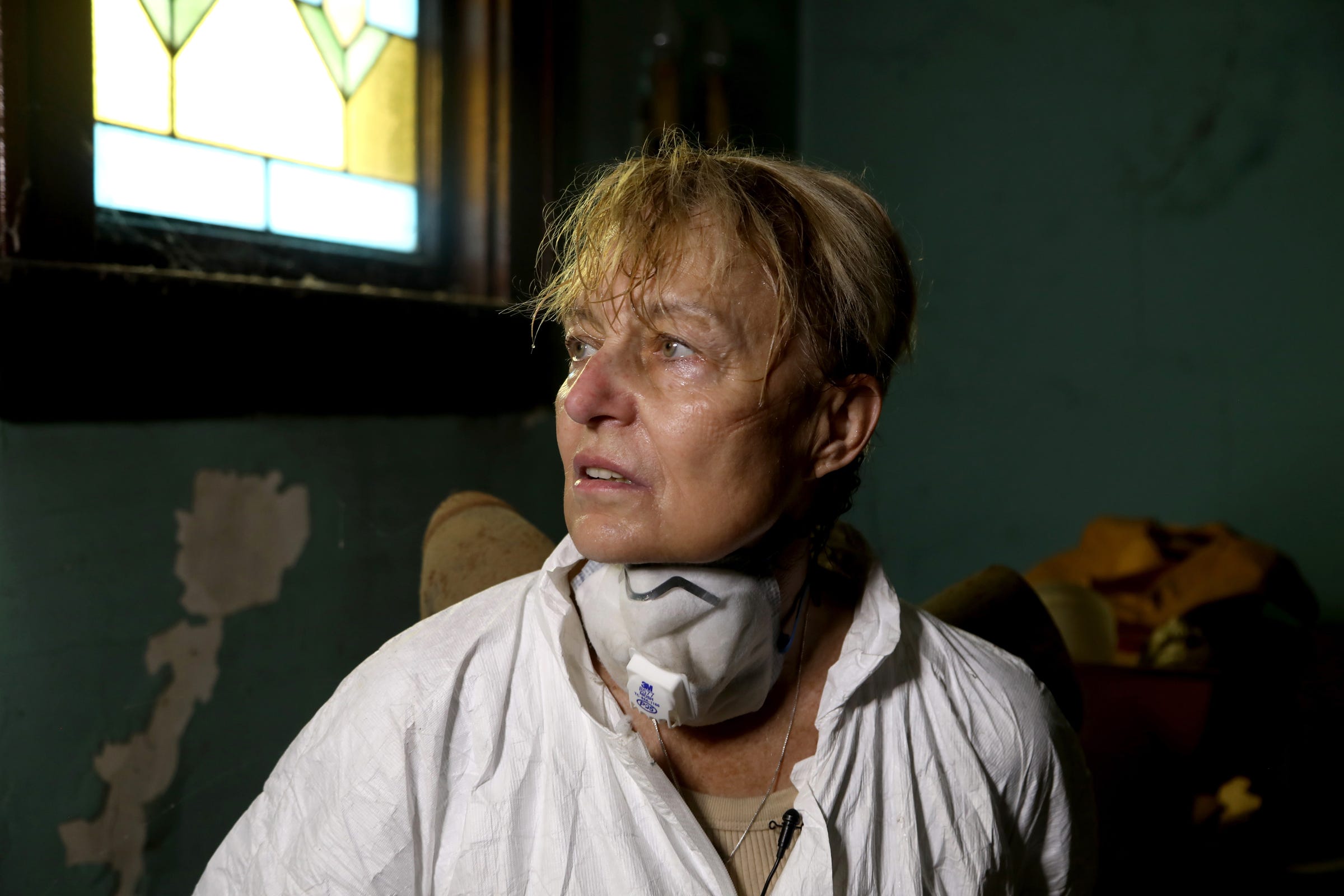
Detroit police Sgt. Nicole Kirkwood said that constabulary fabricated 2 well-checks on Honeycheck that day, but could not interruption in considering it was confronting protocol.
"We merely tin can't break into a person'southward business firm," Kirkwood said. "Law can only enter under exigent circumstances."
Those circumstances, Kirkwood explained, include evidence of a crime or fatal accident, such as blood on a wall, a body on the flooring, someone is heard screaming or shots are fired. She said someone's life must be in danger or jeopardy for constabulary to break in.
In the case of Honeycheck, Kirkwood said, law acted accordingly.
"They checked the mailbox. There was no mail service. They talked to the neighbors. They knocked on the door. They responded twice," Kirkwood said of the Detroit constabulary officers, adding "They kept in contact with the cousin with what was going on."
For Kajma, it wasn't enough.
The tragic tale and death of a hoarder
80-year-quondam Sally Honeycheck was establish dead in the chair she slept in by cousin Linda Kajma. She was partially eaten by her dog Jack and rats.
Eric Seals, Detroit Free Press
Within 2 days of meeting police at the house, Kajma learned from hospital staff that both Honeycheck sisters had been transported to Detroit Receiving. It was Emerge Honeycheck who had chosen 911 when her sis suffered the stroke on Nov. 10.But when emergency crews arrived and saw the living conditions, they called for a 2nd ambulance to get the other sister too.
According to Kajma, infirmary social workers were hoping to convince Emerge Honeycheck to leave the house. But Honeycheck checked herself out of the hospital at 1 a.m. on Nov. 12, telling hospital staff: "I take to go feed the dog."
That's the final time anyone reported seeing her.
'I'm breaking in'
On Thursday, Nov. 29, Kajma reached a breaking point. She said a detective chosen her and said that Sally Honeycheck actually wasn't missing because she was of sound heed when she checked herself out of the hospital.
Kajma had had enough.
The next day, she called police and told them: "I'k breaking into that business firm. I'm telling you ahead of time then you don't arrest me for breaking and entering."
Some 24 hours later, she returned to the house with a friend who was a retired Detroit police officeholder. It was Dec. one, a cold Saturday afternoon. Adrenalin pumping, Kajma threw on a hazmat suit, grabbed some bolt cutters and busted the padlock on a cellar door. There were stairs and some other door to the main level. She kicked her way in.
"Oh my God. It was then icky," she said. "There was garbage a foot deep."
The first room she entered was the kitchen, where she passed the puffy trunk in the blue lawn chair. Leg bones came out of each pant leg. She saw a skull and what she idea was a wig.
"What the hell is wrong with them?" she recalled thinking of her cousins, convinced the figure in the chair was a Halloween prop. She kept going, finding the dog in the dining room. She then went back outside.
"Did you come across her?" her police friend asked.
"'No," she answered, "but they got a Halloween decoration in the kitchen."
By so, the police had arrived.
"They said, 'C'monday Linda, we'll become in with you,' " she recalled.
It was then that everything went blurry. While in the kitchen, in front of the blue lawn chair, a police officeholder said, " 'Linda, she's right here ... the canis familiaris has been eating on her.' "
Kajma'south knees gave mode. The room started to spin. Police grabbed her and took her outside.
A coroner named Reggie appeared.
"I'yard sorry for your loss," she recalled him saying.
"I lost it. I didn't know it was a dead trunk. I was angry at this point," said Kajma, who asked if she could get dorsum in to say her goodbyes.
"I was stunned. I'm sitting in a truck going, 'Where am I? What the hell is going on?' " she recalled.
The coroner took more pictures and so came out of the house.
"Nosotros'll have intendance of her," she recalled the coroner saying. "The funeral home will deliver her remains."
The Wayne County medical examiner concluded Honeycheck died of natural causes and plant there was "extensive postmortem fauna consumption of torso." The time of death was listed equally 1:40 p.m., December. 1, 2018 — the day her trunk was found.
But Kajma believes her cousin died at least a week before that date. She cited the police well-check on Nov. 26: The dog wasn't barking.
Die-difficult Detroiter loved Tigers, Catholic Church building
Sally Honeycheck was born in Detroit in 1938 and spent her entire life on the city's east side. She grew up in what was known every bit the Immaculate Conception neighborhood, a one-fourth dimension thriving community of first and second generation Polish immigrants that was bulldozed to brand fashion for the General Motors Poletown constitute.
Her begetter had a government job; her mother was a housewife. She never married, though she was once engaged to a cook named Dennis who moved away to New York. For years, she kept a 1967 photograph of her and an unnamed fella property hands in her then tidy firm.
The photo captures a immature adult female in a fitted Peter Pan collar top and pencil skirt, kneeling on the floor and staring into the camera, while a dark-haired human being in a spiffy necktie and shirt stares at her.
This was Sally Honeycheck before her dark days. A youthful twenty-something with a flair for style. She wore pearls, fitted dresses, lipstick and fashionable hats. As a piffling girl, she resembled Shirley Temple, with blond loose curls and a pouty smile — her youthful prototype captured in a framed photograph that hung in the living room.
Like almost of the girls in her neighborhood, Honeycheck attended Cosmic schools. She did centre school at St. Hyacinth and graduated in 1957 from the now-closed St. Stanislaus High School. After graduation, she took courses at a business concern school and spent all of her adult life working as an insurance adjuster in Troy, processing claims until retiring in 2009.
Honeycheck was a huge Tigers fan who collected sports memorabilia and knew the names of every manager in major league baseball game. Her social life, though, involved generally church functions.
"She was a very pleasant and very wonderful person," said Elaine Tworek, 79, of New Baltimore, who graduated high school with Honeycheck and attended church building events with her as an adult. "She went before her fourth dimension I call back."
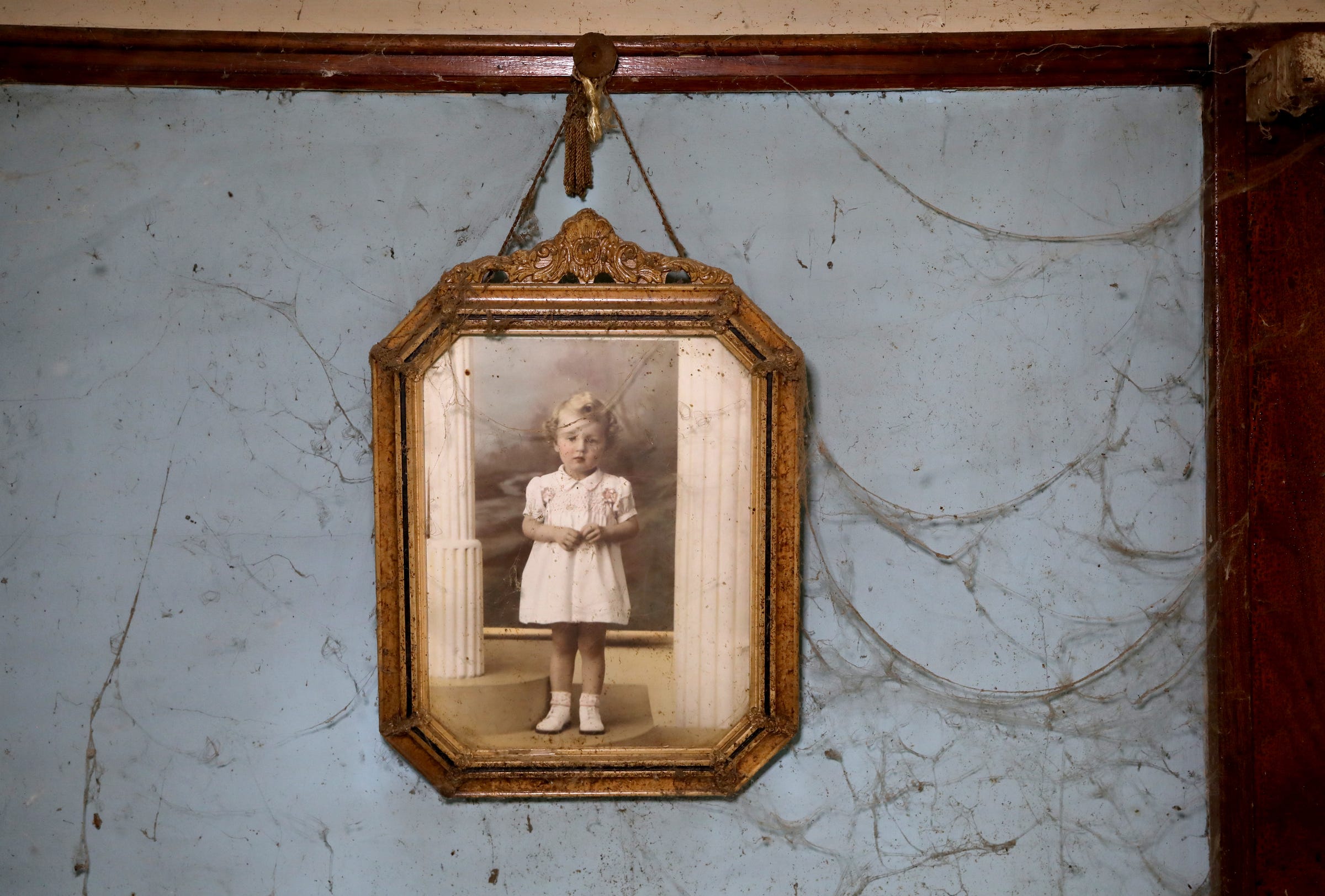
Tworek, who left the neighborhood in 2001, attended monthly church dinners with Honeycheck, along with banana festivals and blessing-of-the-Easter-basket rituals. She sometimes gave Honeycheck rides to the medico in Hamtramck when her friend wasn't feeling well enough to drive herself.
Tworek said she didn't know anything was wrong with Honeycheck until final Thanksgiving, when she didn't get her usual vacation telephone telephone call from her friend.
"I called several times. We went by her house. Nosotros rang the doorbell ... Nobody would answer the door," said Tworek, who got worried and started calling area hospitals.
Eventually, she learned that a Honeycheck was at Detroit Receiving, simply it was Emerge's sis, Lorraine, who couldn't talk due to her stroke. The hospital told her they were looking for Sally, but couldn't detect her.
Within days, Tworek learned about her friend'south tragic death from Kajma, who had found her phone number in Honeycheck's holding and called her with the news.
"I felt very bad," Tworek said. "I felt that perchance, if I had called the police or something, they could have saved her. But I didn't call anybody."
Patti and Bill Galen, the owners of the nearby Ivanhoe Cafe, known equally the Shine Yacht Club, too are troubled by Honeycheck's expiry.
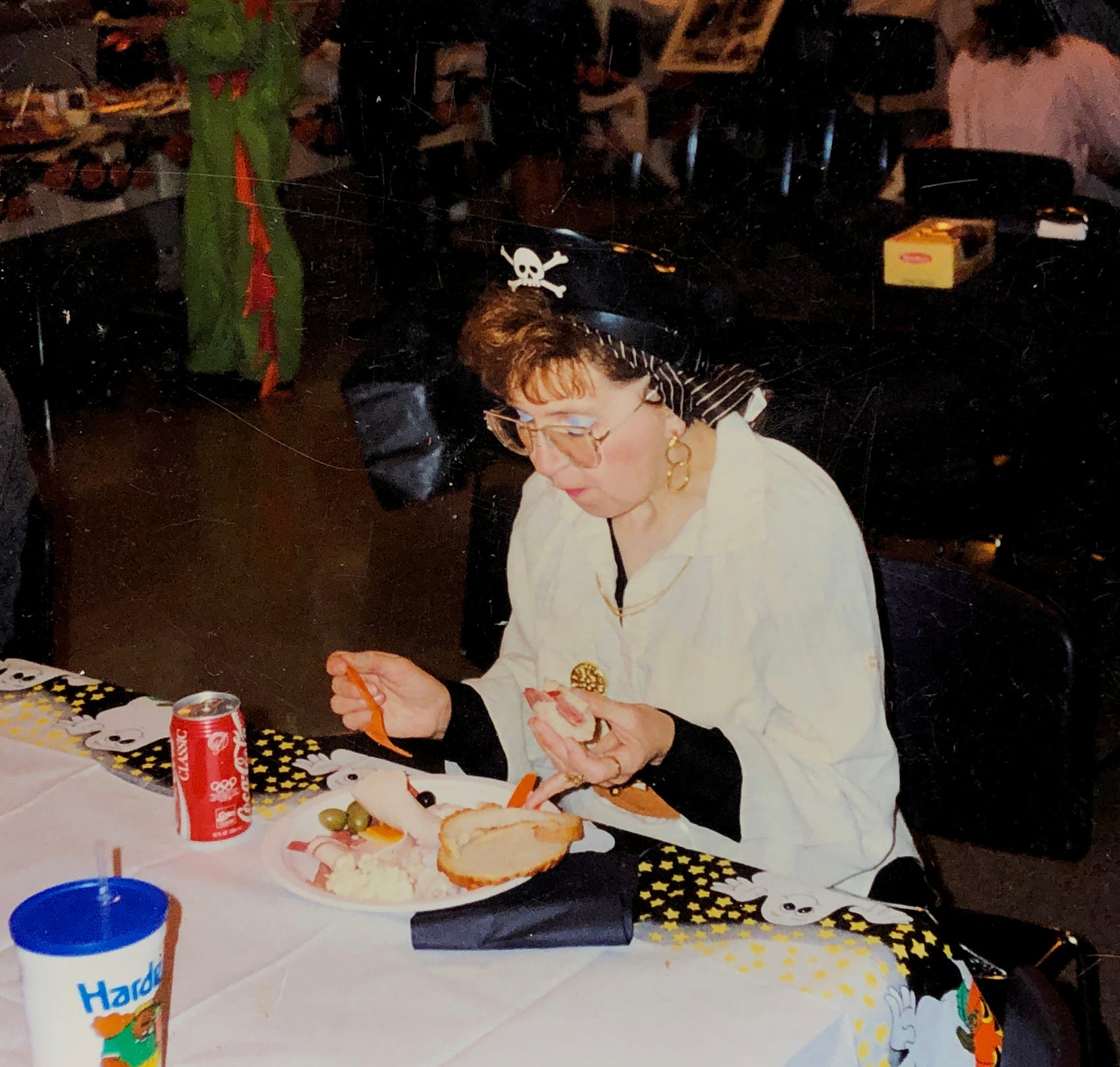
"We didn't know she was living that badly," said Patti Galen. "We used to accept food to her all the time ... She was a sweet lady who minded her ain business ... and she always gave usa a tip."
The Honeychecks were regulars at Ivanhoe, though in the terminal year they stopped walking over to the eating house and chosen in their orders instead. Two perch dinners. Walleye and grilled kielbasa. That'south what they loved. And they always left a dollar tip, the workers said, smile.
Russell Palmer, a dishwasher at Ivanhoe's known as Picayune Rusty, used to evangelize food to the Honeychecks. He would knock on the front door. When they answered, he handed off the numberless.
"They were friendly," he recalled. "They always seemed fine, two sisters living together."
Just they never permit him within.
The staff at the Ivanhoe Cafe didn't know annihilation was wrong with the Honeychecks until the owners got a call from Kajma in Nov, asking if they'd seen Sally or Lorraine and whether they would bank check on them.
The Galens obliged, merely the Honeycheck business firm stayed quiet. The blinds never moved.
A mental health disorder
According to the International OCD Foundation, hoarding disorder affects up to 6 per centum of the U.S. population, or nineteen million Americans. It's not just a discussion to describe messy people who collect clutter; It's an illness, recognized by the psychiatric profession.
In 2013, hoarding disorder was added in the latest revision of the American Psychiatric Association's diagnostic manual. Information technology affects men and women at similar rates, and is believed to be a universal miracle affecting all races, ethnic groups and cultures.
The fundamental characteristic of hoarding disorder is not ataxia, only difficulty letting go of possessions that interfere with the ability to live.
Honeycheck's home matched this clarification. The beds could not exist used for sleeping. The sofa and chairs could not exist used for sitting. Appliances didn't work. And boxes of ataxia overtook every room, filled with everything from greeting cards and unopened bags of habiliment to Avon makeup boxes, jewelry and sports memorabilia.
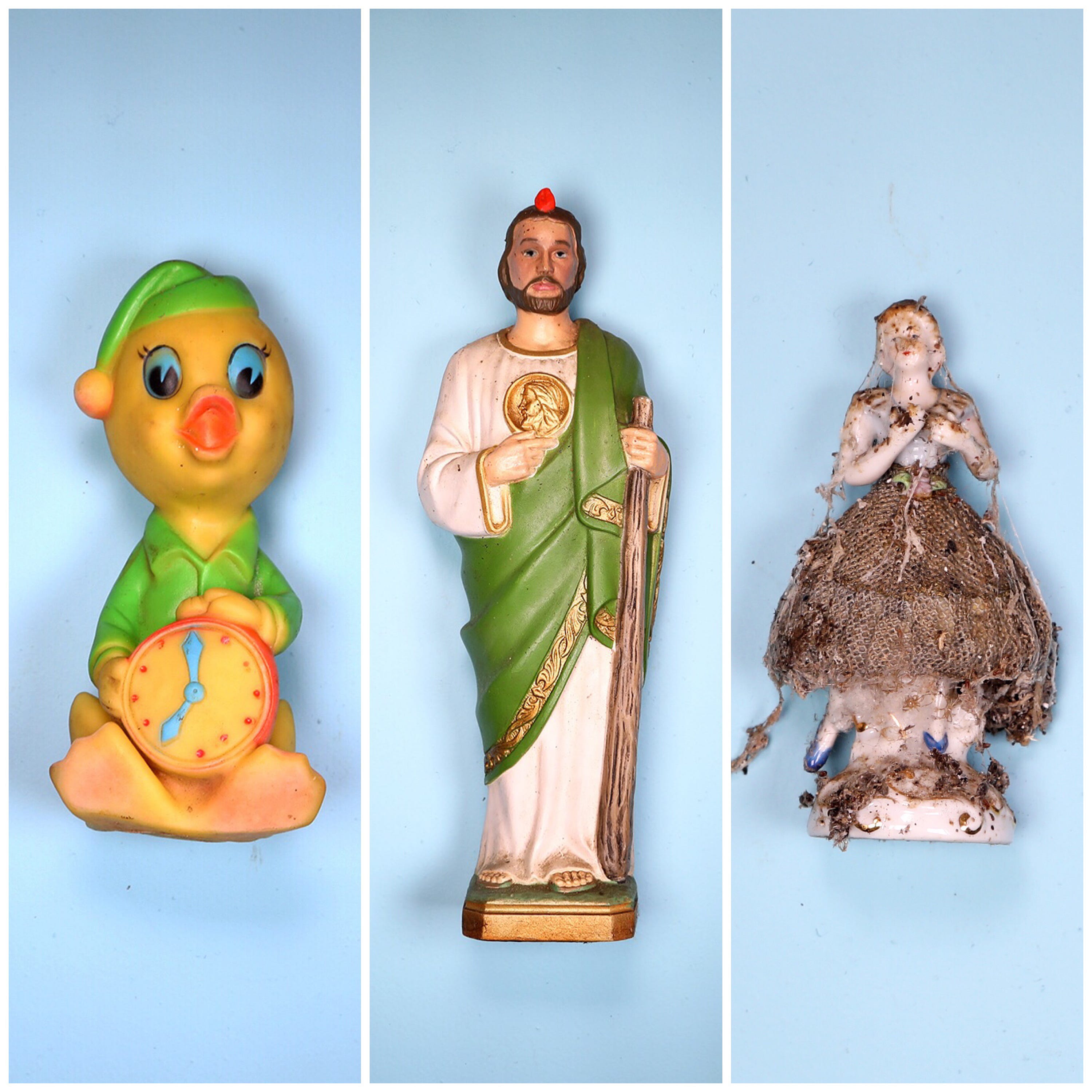
"It'due south like an addiction in that the person merely cannot let get of possessions," said Randy Frost, a psychology professor at Smith College in Northampton, Massachusetts, and co-writer of "Stuff: Compulsive Hoarding and the Pregnant of Things."
Hoarding is especially difficult for family members to deal with, said Frost, noting that marriages sometimes end or children move out when the living weather become deplorable. And efforts to help fix the problem tin can seem futile, he said.
Family members may want to help, simply they don't know how. Cleaning up the space and throwing out their property can only make matters worse, Frost said.
"The person with the problem feels violated. They've been traumatized ... anything they own is a function of them," he said, noting hoarders will sometimes ban relatives from visiting if they endeavour to throw abroad their things, or propose doing so.
In the Honeychecks' case, no ane threatened to throw out their stuff because they hid their ataxia from the globe. Frost said when hoarding turns into squalor, that suggests that a person may be suffering from dementia, Alzheimer's, or other disorders that interfere with an ability to live in an organized way.
The Honeychecks as well didn't take visitors, which Frost said is a crucial part in helping people with hoarding disorder.
"If nothing else, just visit them in their homes," Frost said. "You don't have to talk about the ataxia ... even if you just visit ... no matter how bad the hoarding is, the person will exercise something to make the environment more normal for the visitor."
Frost stressed: "The ataxia gets worse when people stop visiting."
The Honeychecks had shut the globe out.
"What do you lot exercise?" said Kajma, who believes her cousins' hoarding was out of her command. "How does information technology change if you don't let us in the firm."
Kajma wished she had known virtually the stroke that landed Honeycheck's sister in the infirmary.
"If Sally had told me Lorraine was in the infirmary, I would take been calling them sooner and more than oft," she said. "Maybe that could have prevented her untimely decease, or at least she would have been found sooner — and perchance before the domestic dog and rats did."
'I cried for her'
The final viii months accept been mentally, physically and emotionally exhausting for Linda Kajma, who was left with the sole responsibility of handling her cousin's manor and affairs.
Kajma had to make clean the house, locate insurance policies and depository financial institution statements, and make certain Lorraine had a safe place to alive: she'southward now in a nursing abode in Oakland County.
In the center of this ordeal, her female parent, Virginia Kajma, died in February.
"I am in the midst of a nightmare," Kajma said during the spring, when the cleaning process started.
But Kajma, with her salty personality and razor-precipitous wit, held it together and took care of Sally Honeycheck'southward affairs.
For weeks, Kajma fought the stench and dug through the rubbish with a loyal coworker named Tamara Tracy, a 46-year-old receptionist at an accounting firm who donned a hazmat suit in 80-caste temperatures to help clean the Honeycheck house. The duo cleaned for 20 minutes at a time, the odor too overpowering to get any longer. They sorted through decades of memories, trying to figure out what to keep and what to toss, and looking for clues as to what led the sisters down this sad, tragic path.
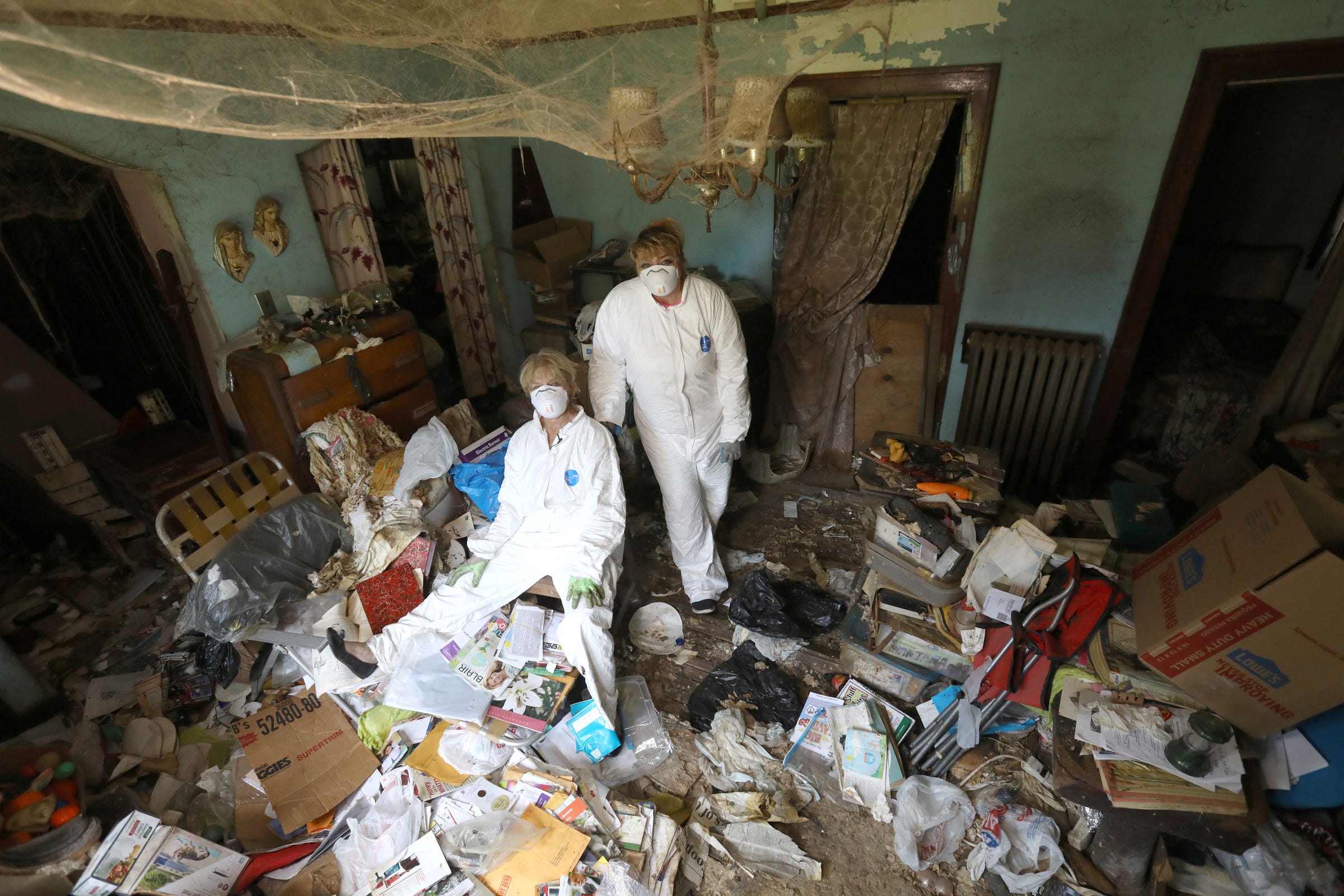
"This is sick," Kajma said one July afternoon as she rummaged through the debris: a McDonalds receipt for xx cheeseburgers. Empty Jet's Pizza boxes. Lipton soup containers.
"I'grand looking for anything, anything of value," said Kajma, who was determined to find a violin that her female parent once played as a child. She didn't find the instrument, but believes she found the receipt for it. Dated 1925, the National School of Violin receipt read $40.
The house on Joseph Campau was full of subconscious cash — $10 and $twenty bills tucked everywhere. And rat carrion. In the cupboards. Beds, flooring. Everywhere.
"I tin't believe it. I can't believe people live similar this," Kajma said. "How could you breathe in hither."
Kajma didn't cry for weeks. She was consumed by anger for awhile, noting that she had warned her cousin a few years ago that she needed to get her diplomacy in society. She recalled doing this over a beer with her cousin at the Smooth Yacht Club three years earlier her decease.
"I told her to get a will. Somebody needs to know what you want. I don't want to be the one to have to break in one 24-hour interval and find two dead bodies," Kajma recalled telling her.
"And hither nosotros are."
Kajma believes her cousin's mental health deteriorated subsequently she retired virtually a decade ago. She institute photos from 2003 that showed the house was clean and organized, just as she remembered it when she visited at that place in her youth, when she used to finish to get together lilacs from the bushes.
The lilac bushes are nevertheless there. The house is now all cleaned up. Kajma prepare aside some valuables: family unit photographs, a golden cross, quondam pottery and ceramics. She even has an offer on the house.
The reality has sunk in. A few days ago, she read the dissection study for the start fourth dimension. The gruesome details broke her.
"I cried for her," she said. "I cried for her, finally."
Contact Tresa Baldas: tbaldas@freepress.com
Source: https://www.freep.com/in-depth/news/local/michigan/detroit/2019/08/01/detroit-hoarder-squalor-dead-eaten-dog-sally-honeycheck/1492124001/
0 Response to "U.s. A Baby Dies Amid Squalor. And a Family's Secret Is Revealed"
Publicar un comentario